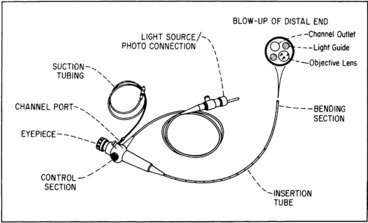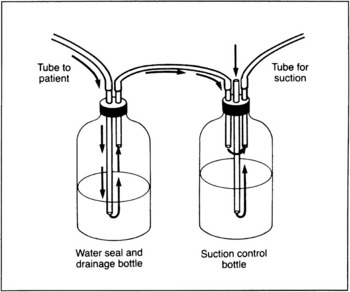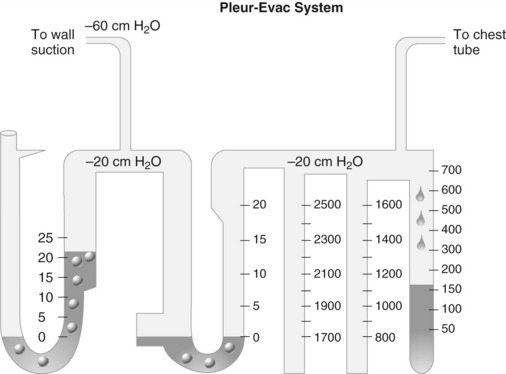CHAPTER 5 SPECIAL RESPIRATORY CARE PROCEDURES
PRETEST QUESTIONS
1. Which of the following are complications associated with bronchoscopy?
2. While assisting with a bronchoscopy, you note that the physician is having difficulty entering the trachea. This may be the result of which of the following?
3. After a bronchoscopy, the respiratory therapist notes that it is taking more ventilator pressure to ventilate the patient’s lungs than before the procedure. This could be caused by which of the following?
4. To aid in the evacuation of air from the pleural space, a chest tube should be inserted at what level?
5. The respiratory therapist notices on a patient’s chest tube drainage system that there is fluctuation of the water level in the water-seal chamber with each patient breath and air bubbles seen only in the suction control chamber, which has a suction pressure of −15 cm H2O. The most appropriate action is which of the following?
6. The respiratory therapist observes that, during a patient’s breathing cycle, there is no fluctuation in the water-seal chamber of the pleural drainage system. The most appropriate action is which of the following?
REVIEW
CRT Exam Content Matrix: IC2, IIA25, IIIJ2
RRT Exam Content Matrix: IC3, IIA11, IIIJ2

FIGURE 5-1 Rigid bronchoscope.
From Scanlan CL, Simmons KF: Airway management. In Scanlan CL, Wilkins RL, Stoller JK: Egan’s fundamentals of respiratory care, ed 7, St Louis, 1999, Mosby.

FIGURE 5-2 Fiberoptic bronchoscope.
From Scanlan CL, Simmons KF: Airway management. In Wilkins RL, Stoller JK, Kacmarek R: Egan’s fundamentals of respiratory care, ed 9, St Louis, 2009, Mosby.
II. CHEST TUBE INSERTION AND MONITORING
CRT Exam Content Matrix: IIIJ5
RRT Exam Content Matrix: IIIJ5

FIGURE 5-3 One-bottle system.
From O’Toole M, editor: Miller-Keane encyclopedia and dictionary of medicine, nursing, and allied health, revised revision, Philadelphia, 2005, Saunders.

FIGURE 5-4 Two-bottle system.
From O’Toole M, editor: Miller-Keane encyclopedia and dictionary of medicine, nursing, and allied health, RR, Philadelphia, 2005, Saunders.

FIGURE 5-5 Three-bottle system.
From O’Toole M, editor: Miller-Keane encyclopedia and dictionary of medicine, nursing, and allied health, RR, Philadelphia, 2005, Saunders.
POSTCHAPTER STUDY QUESTIONS
1. List five indications for bronchoscopy.
2. List eight complications of bronchoscopy.
3. Name one medication that is commonly used to achieve conscious sedation before bronchoscopy.
4. What is the purpose of administering atropine before bronchoscopy?
5. How should the bronchoscope be cleaned after the procedure?
6. What is the purpose of inserting a chest tube?
7. If the water in the water-seal bottle is not fluctuating, what should be suspected?
8. If a chest tube becomes obstructed, what may occur?
9. If an air leak from a chest tube is suspected, what should be done first?
10. How much negative pressure is generally required to help evacuate fluid or air from the pleural space?
Des Jardins T. Cardiopulmonary anatomy and physiology: essentials for respiratory care, ed 4. Albany: Delmar; 2002.
Hess D, Respiratory care principles and practice, ed 1, Philadelphia, Saunders, 2002.
O’Toole M, ed. Miller-Keane encyclopedia and dictionary of medicine, nursing, and allied health. RR, Philadelphia: Saunders, 2005.
Scanlan CL, Simmons KF, Airway management. Scanlan CL, Wilkins RL, Stoller JK. Egan’s fundamentals of respiratory care, ed 7, St Louis: Mosby, 1999.
Scanlan CL, Simmons KF, Airway management. Wilkins RL, Stoller JK, Kacmarek R. Egan’s fundamentals of respiratory care, ed 9, St Louis: Mosby, 2009.
Wilkins RL, Stoller JK, Kacmarek R. Egan’s fundamentals of respiratory care, ed 9. St Louis: Mosby; 2009.




